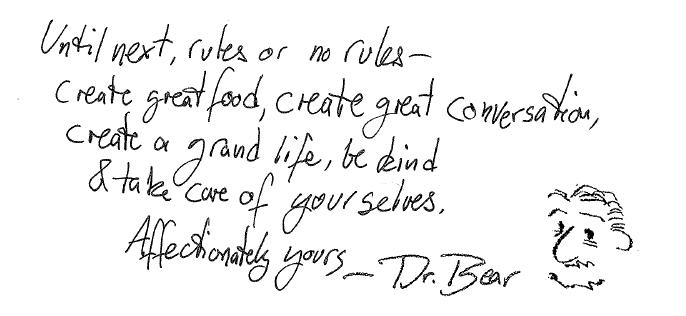 What we have here, is a bed of sautéed greens–chard, mustard greens & arugula sautéed with some garlic, soy sauce & sesame seeds–over that a nest of locally grown and ground corn grits, some cheddar, and then a poached egg. For presentation, we added some tomato, some orange and purple bell peppers, and topped it off with sriracha.
What we have here, is a bed of sautéed greens–chard, mustard greens & arugula sautéed with some garlic, soy sauce & sesame seeds–over that a nest of locally grown and ground corn grits, some cheddar, and then a poached egg. For presentation, we added some tomato, some orange and purple bell peppers, and topped it off with sriracha.
Fine with coffee, tea, or Duck-Rabbit Wee Heavy Scotch Ale.
Audio Post, October 24th, 2013: Mind your Happiness
As usual, for all my late-night, sleepless friends, here is the audio version of tonight’s entrée. Think.
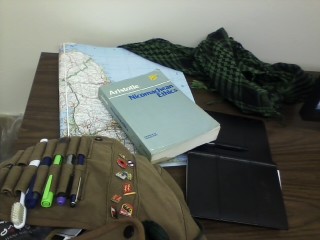
Mind your Happiness
What is it that we want more than anything else?
What is it what we work those long hours at jobs for, keep relationships alive for, save for, spend for, climb into the mountains for, drive into the city for, sit and wait for, climb those trees for?
Happiness.
 Even the closest rivals for what we might want more than anything else—that 22 year old single malt, that night dancing, that meringue, the sweet heat and tingle of physical pleasure, the intoxicating exhilaration of power, success, money—these are all things we desire in the faith (or the hope) that they will make us happy. But these are all fleeting, and too dependent upon the black and red wheel of fate or upon the whims of others.
Even the closest rivals for what we might want more than anything else—that 22 year old single malt, that night dancing, that meringue, the sweet heat and tingle of physical pleasure, the intoxicating exhilaration of power, success, money—these are all things we desire in the faith (or the hope) that they will make us happy. But these are all fleeting, and too dependent upon the black and red wheel of fate or upon the whims of others.
What we want is happiness and fulfillment.
Aristotle argues that happiness is the end towards which all our  human means are ultimately aiming, and that a happy human life is irrevocably tied to what it means to be human. To be a human being is ultimately to be a social being, and a rational being, so any account of human happiness will be an account of the character and types of actions and activities that allow us to find fulfillment—both socially and intellectually. The little ball on that wheel might not land on our number or even our color, and we might be smacked around by an indifferent world and cruel compatriots, but as far as our striving towards human flourishing, towards happiness, towards fulfillment is dependent upon our choices, we can cultivate virtues, excellences of behavior, and of the mind.
human means are ultimately aiming, and that a happy human life is irrevocably tied to what it means to be human. To be a human being is ultimately to be a social being, and a rational being, so any account of human happiness will be an account of the character and types of actions and activities that allow us to find fulfillment—both socially and intellectually. The little ball on that wheel might not land on our number or even our color, and we might be smacked around by an indifferent world and cruel compatriots, but as far as our striving towards human flourishing, towards happiness, towards fulfillment is dependent upon our choices, we can cultivate virtues, excellences of behavior, and of the mind.
That, my friends, is a very concise summary of Aristotle’s Nicomachean Ethics.
I’ve discussed the virtues of character elsewhere, and will again, I’m sure, but this week, I was struck by his discussion of the virtues of the mind. One reason I have tended to breeze through this part is because it is a bit vague, technical, and abstract, but especially because the moral virtues are so much easier to have discussions about. However, the main reason is because I have always associated Aristotle’s account of the importance of the development of the mind in general, and the importance of contemplation and the acquisition of wisdom with Plato’s contemplation of the forms. Aristotle’s account is much richer than that, though.
To be happy, to be fulfilled, to be self-actualized—whatever vocabulary you prefer—one must cultivate the mind, but also exercise it, and in all its dimensions.
He talks of φρόνησις—judgment—how we understand and choose appropriate behavior, the practical decision making of living with others. This is savoir-faire, a kind of knowing, but a way of knowing what to do, and as much a skill as a matter of content knowledge.
I think that the importance of exercising this part of the mind might go without saying—although we might not realize its importance in ourselves, we certainly recognize the lack of it in others—not just crudeness and lack of conscience, but an inability to recognize how are actions can make others happy or ruin their day. Since we no longer live within the confining certainties of Jane Austin’s world, we find ourselves largely playing this one by ear—I know killing is wrong, but when do I send a thank-you note? Even if you do not know the specifics, you can exercise some judgment:
if you do not hold the door for others, you are not a gentleman.
if you are unkind to the wait staff, you are not a good human being.
if you are cruel to children or animals, you are not human.
These are not open to interpretation.
He talks of τέχνη—skill—how we know how to do things. Like most philosophers, Aristotle privileges the abstract over manual labor, but he does recognize that craft and skill are important (he was, after all, a physician, a skill I appreciate). He also recognizes the way in which the knowledge of the hands is a form of knowledge.
To stretch the parts of our minds which create is as pleasurable as stretching our back muscles in the warm sun; to make something good is one of the most fulfilling things a human can do; to make something beautiful is to build ourselves a bit more soul. To not be allowed to make things, to not be able to cultivate skills which we know are ours, to merely process or move things back and forth, or to shuffle papers and figures for a living is deadening.
He talks of ἐπιστήμη—knowledge—and of νοῦς—understanding—both of which are ways we know things. He sometimes makes the distinction of knowledge being about knowing things, whereas understanding being about understanding the abstractions behind them (and wisdom being the understanding the first principles behind everything), but I like to think of them as knowing facts and data—Turkey is in Asia, Sweet Potatoes & Yams are not the same things, the average airspeed velocity of an un-laden European Swallow is roughly 11 meters per second or 24 miles an hour, etc. Understanding can go beyond this raw data and build upon it.
As anti-intellectual as we sometimes can be, the fact remains that we human beings derive pleasure from knowing and from understanding. We want to figure out what that 5 letter word at 8-down is, how to get all 9 numbers in each of the 9 squares, and we want to beat the dweebs on Jeopardy. We do memorize baseball statistics and keep track of basic Tardis data. We try to understand how UT might finally get a winning football team again and how the living dead move. We want to know how Sherlock survived his fall and where the second gunman on November 22nd 1963 was.
Of Aristotle’s fifth intellectual virtue, Σοφία—wisdom, sweet wisdom, holy Sophia, gift of Athena—I have, and will continue to write of her.
Using our minds is a necessary part of human happiness; if we have nothing to think about, we are miserable. Boredom gets us into more trouble than almost anything else.
When I talk to people suffering from losing the ability to discipline their thoughts, they are really suffering. To lose one’s mind is, of course, tragic, but even to lose bits of memory and reasoning is terrifying and terrible.
So exercise your mind—use your judgment, your skills, pick up new information and gain new understandings; not everyone can win at blackjack every time (except, so far, Summer), but you can use your mind, you can control this puzzle-piece of your happiness.
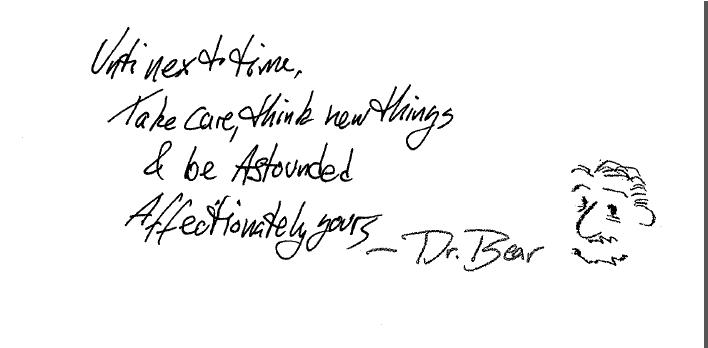
Classic Pie Crust
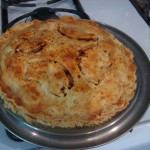 …and by classic, I am afraid I might mean Crisco®, because they are the ones from whom I garnered this recipe. I have always preferred pie to cake, but the crusts take a bit of practice to make. My mother is an incredibly good pie maker, and even worked for a time cranking out pies for a place called “Mom’s Pie Factory.”
…and by classic, I am afraid I might mean Crisco®, because they are the ones from whom I garnered this recipe. I have always preferred pie to cake, but the crusts take a bit of practice to make. My mother is an incredibly good pie maker, and even worked for a time cranking out pies for a place called “Mom’s Pie Factory.”
This is enough for one single crust. For two pastry shells or a pie with a top crust, double the recipe. Not rocket science, folks.
Ingredients:
- 1 cup all purpose flour
- 1/2 tsp salt
- 1 pinch of sugar
- 1/3 cup ice cold solid shortening
- 2 Tbsp ice cold butter
- 3 Tbsp ice cold water
Step 1, sifting the dry ingredients: In a large bowl sift (mix if you don’t have a sifter) the flour, sugar, and salt. Mix thoroughly.
Step 2, pastry cutting: Cut in the ice cold shortening and sliced butter,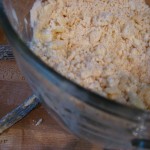 using either a pastry cutter or a knife. I suppose some processer thingy can do this, too, but I don’t own one. The result should be crumbly.
using either a pastry cutter or a knife. I suppose some processer thingy can do this, too, but I don’t own one. The result should be crumbly.
(Just a note: with pie crusts and crackers, you are, in effect, using the oils to fry the flour, this is what makes it crispy and flakey)
Step 3, adding the water: as simply as possible–working pie or biscuit dough too much makes it tough–add in the water. It needs just enough to make it a dough, not any more.
Step 4, roll with it baby: Flour a clean, smooth counter surface (tables, desks and 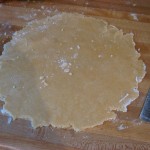 sarcophagi will do, too, just so it is smooth, cool, and has plenty of space), and a rolling pin. flour the ball of dough, and pat it down to spread it out. Roll out the dough gently, a little at a time, starting from the middle and moving outward. if the edges become raged, moisten them, fold them in, and roll them again.
sarcophagi will do, too, just so it is smooth, cool, and has plenty of space), and a rolling pin. flour the ball of dough, and pat it down to spread it out. Roll out the dough gently, a little at a time, starting from the middle and moving outward. if the edges become raged, moisten them, fold them in, and roll them again.
Step 5, into the pan: transfer the rolled out crust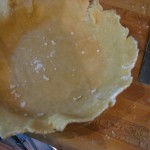 into the pan. You might roll it onto the pin and unroll it, or a variety of strategies–I loosen it from the counter with a spatula, and then slide it to the edge and over/into the pan. Pat it down, trim or fold the edges of the dough over, and then crimp the edges. some folks like fork prints, I like to pinch a wavy zig-zag edge meandering around the pan.
into the pan. You might roll it onto the pin and unroll it, or a variety of strategies–I loosen it from the counter with a spatula, and then slide it to the edge and over/into the pan. Pat it down, trim or fold the edges of the dough over, and then crimp the edges. some folks like fork prints, I like to pinch a wavy zig-zag edge meandering around the pan.
Step 6, baking: Bake the shell by itself if you are going to fill 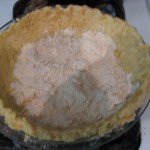 it with something, or insert your ingredients here. (to be continued…)
it with something, or insert your ingredients here. (to be continued…)
Audio Post, October 17th, 2013: Where do I go from here?
As usual, for all my late-night, sleepless friends, here is the audio version of tonight’s entrée. Dream.

Where do I go from here?
Last week, I was serving drinks at the Bistro bar when someone asked: “Where do you go when there is nowhere left to go?”
It is a question I have been asking myself for over a year now. “Maybe it’s the time of year, or maybe it’s the time of man,” or maybe it’s the time of life in which I find myself, but there seem to be more walls and fewer horizons in my life than there used to be.
One option, of course, is to try to retrace, to try to go back to a time when there seemed to be endless possibilities—or, at least, there still seemed to be possibilities, or to try to recapture that person you once where, and then try to look for new directions, either new possibilities that might have been forgotten or over-looked, or new insights from rediscovering your earlier self.
It is not a bad start, and it may clear your head, but—informative as the past might be—the past is past. As Thomas Wolfe famously pointed out, “you can’t go home again.”
The past is a lovely place to visit, but a person has to find another place to live.
Another alternative is resignation, to choose to embrace the present, to look beyond the problems and limitations that seem to haunt you, and even the numbing dead-ends and losses of your professional and personal life, and to lose yourself in the moment, such as it is, one way or another.
Of course, you can deaden the present, and find solace and comfort where you can, looking for your own personal safe havens or clean, well-lighted places. This may avoid the problem, but it still leaves you with a slow, shuffling specter of yourself to live with.
Heidegger once said that without any real hope of progress, all that remained for the thinker was to prepare a place, a clearing, for the return of god. By and large, this seems to be the last philosophical suicide by an old man whose philosophical acuity had died decades earlier, not having survived his personal integrity by long. Are we worth saving if only a god can safe us?
However, passively resigning to fate and minimizing the desires of the self which connect us to this world is, for many, a viable strategy. This has been part of the rich heritage of Buddhism: to not gorge yourselves upon this world and your own self until you become trapped and wallowing like a fattened banana-fish. Accept the illusion of selfhood, and transcend it.
While it may be selfish to desire things, and it may be selfish to build up oneself—or even build protective walls around oneself—at the expense of others, it is not selfish to demand to have one’s own self, and perhaps even a place of one’s own. To be is to be myself; my own pain is not an illusion to be overcome, but is a part of me. My scars are my skin, and my skin is my scars, and I am both.
Another similar alternative is to seek comfort in the close company of others, to lose oneself either in the warm embrace of friends, or of family, or of other communities. This may diminish the discomfort, or may make it more bearable, but the heart resists and the mind wanders.
To be companions is more than just sitting and breaking bread—it is to be on a journey together, and this needs motions and change, destruction and growth, and perhaps even loss. However, to move is to live; Allons-y!
A final alternative that remains is re-invention. No, we can’t change the past, and we can change very little about the present, but the future will always be infinite possibility. There are limits to how far you can re-imagine yourself, but those limits are only slightly smaller than your imagination. The world will set limits on us, but the walls will close in on us and crush us eventually, so why not try to scale them? Why not leap?
Rage, rage! Dare! Sound your barbaric YAWP over the roofs of the world! Wear bright yellow! Write new things! Say what you mean! Make cookies with Sriracha, and Scallops with Seitan!
Are you worried about what you will do after you leap?
Biscuits & Gravy
I had never tasted biscuits and gravy until I was in my teens.
 When I finally did, I believed I had discovered ambrosia, the food of the gods (there is a dish commonly served up as “ambrosia,” but it is a sickening, gloopy abomination). In fact, one of the reasons I originally chose to move to the South was that it was a place that I could get biscuits and gravy.
When I finally did, I believed I had discovered ambrosia, the food of the gods (there is a dish commonly served up as “ambrosia,” but it is a sickening, gloopy abomination). In fact, one of the reasons I originally chose to move to the South was that it was a place that I could get biscuits and gravy.
If done right, the biscuits are crisp and buttery on the outside, but soft and either flakey or cake-like on the inside, and the gravy is creamy and warm, but also spicy.
When my daughter became a vegetarian, the gravy had to be re-invented.
One of my proudest moments came one Easter a few years back. A friend of ours, Tyler, had given up meat for Lent, and piled up a big plate full of my biscuits and gravy and was digging into them talking about how glad he was to finally be able to eat meat again. We had to tell him he was still keeping his Lenten vows.
The key to biscuits is several things: Don’t over-work the dough, and have a good blend of baking soda or power, fat, and a little bit of something acidic.
Ingredients:
- 2 cups TVP (texturized vegetable protein)
- 2 tsp. Onion Powder
- 2 tsp. Garlic Powder
- 1Tbsp Sage
- 1 tsp. Paprika
- 1 tsp. Worcester Sauce
- 2 tsp. Soy Sauce
- 1/2 cup Red Wine
- a bit of Vinegar
- 1/4 cup Oil
- 1 cup Yogurt (this began as buttermilk, but I like the viscosity of yogurt better; if you are vegan, use some substitute, but add a dash of an acidic, like vinegar or lemon juice; if it is a liquid, use less)
- 1 tsp. Baking Soda
- 2 cups Flour (pastry flour might actually be better, but suit yourself)
- 1Tbsp Baking Powder
- 1 tsp. Salt
- 6 Tbsp cup cold Vegetable Shortening
- a bit of cold butter
- Extra Oil
- Extra Flour (maybe half a cup?)
- Extra Milk (maybe 2 cups, maybe more)
Step 1, gentleman, start your sausages: In a jar or bowl, combine the TVP, seasonings, wine, vinegar, oil, and whatever else suits your fancy. Leave it to soak a bit, you that the TVP absorbs the moisture.
Step 2, start leavening: In a bowl with some extra room (it could expand), combine the yogurt and the baking soda. Let this sit.
Step 4, turn on the heat: Pre-heat the oven to 475 degrees.
Step 5, sift & cut: Sift the flour, the baking powder, and the salt together. Cut in the shortening and the butter, allowing it to form a crumbly mixture.
Step 6, mix: Add the yogurt to the flour, just enough to get it to all stick together; mix it to get this, but as little as possible–only enough to get it all moist & sticking together.
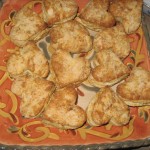 Step 7, roll & cut: Roll the dough out on a floured surface until it is a half an inch or so thick. fold it over, and roll it just a bit. Cut into biscuits with a biscuit cutter, or a juice glass, or a cookie cutter, or a cutlass, or whatever you prefer.
Step 7, roll & cut: Roll the dough out on a floured surface until it is a half an inch or so thick. fold it over, and roll it just a bit. Cut into biscuits with a biscuit cutter, or a juice glass, or a cookie cutter, or a cutlass, or whatever you prefer.
Step 8, bake: Place the biscuits on a greased cookie sheet and bake for 12 minutes, more if necessary.
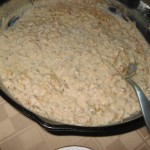 Step 9, the gravy: In a big ol’ skillet with some oil (be generous!), fry the TVP mixture until it gets a bit of texture and brown. Add a few tablespoons of flour and let them absorb some of the oil. Slowly add milk, while stirring, and let simmer.
Step 9, the gravy: In a big ol’ skillet with some oil (be generous!), fry the TVP mixture until it gets a bit of texture and brown. Add a few tablespoons of flour and let them absorb some of the oil. Slowly add milk, while stirring, and let simmer.
Step 10, monkey with the recipe: If it is too thin, dissolve some flour in some more milk and add it too it; if it is too thick, add some milk. If it is too bland, add more salt or sage, or pepper; if it is too spicey, add more milk. when it is fine, turn off the heat or put on low.
Final step, serve: The gravy is traditionally served over a split biscuit, 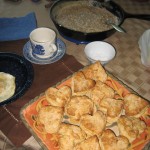 so that it absorbs the gravy, but adds some texture. You can add eggs on the side, or sausage, or whatever you like. You can have extra biscuits to sop up the gravy, or for apple butter. Go out and face the day.
so that it absorbs the gravy, but adds some texture. You can add eggs on the side, or sausage, or whatever you like. You can have extra biscuits to sop up the gravy, or for apple butter. Go out and face the day.
Audio Post, October 10th, 2013: Recipes, Rules, & Realtivism
As usual, for my friends who have trouble sleeping, or for those who just prefer their Bistro aurally, here is the link to the audio version of tonight’s post.
http://philosophybistro.tumblr.com/post/63675212054/as-usual-for-those-of-you-needing-a-sleeping-aid


Recipes, Rules, and Relativism
It recently occurred to me how odd my recipe collection here in my posts is.
From reading here, one would get the impression that I cook mostly muffins; that is not the case. The recipes that I post are for things that I actually bother to follow a recipe  for; most of the things I cook–the stews, pastas, potatoes & rice dishes that make up my day-to-day life aren’t necessarily planned, and certainly aren’t measured–and this is what most cooking, as well as most of my life, is like: I look at what’s available, and I make the best of it. I recently had a wonderful pineapple-coconut-upside-down-pie that long time reader and Bistro regular Rachel had made, but she couldn’t have told me the recipe–she just put in what she thought would be good (and it was).
for; most of the things I cook–the stews, pastas, potatoes & rice dishes that make up my day-to-day life aren’t necessarily planned, and certainly aren’t measured–and this is what most cooking, as well as most of my life, is like: I look at what’s available, and I make the best of it. I recently had a wonderful pineapple-coconut-upside-down-pie that long time reader and Bistro regular Rachel had made, but she couldn’t have told me the recipe–she just put in what she thought would be good (and it was).
There are people whom this drives crazy–they need to be able to measure everything, and they need to know exactly what to do and when to do it. They need hard, fast formulas that they can follow to the letter to be absolutely certain that it comes out right. Lots of recipes are a good thing when you are still just trying to find your way around a kitchen, but eventually, they just become “guidelines.” Apples, potatoes & carrots don’t come in uniform sizes, flour doesn’t come in uniform levels of moisture, even the difference in air pressure on different days can change food–you are working with food, not forcing it to do something.
Now, there are things that matter:
Proportion matters; in oatmeal or rice or other cooked grains, the amount of liquid will be twice that of the grain. The perfect biscuit has a perfect proportion of flour, leavening, shortening, and moisture. It is obviously possible to have too much salt.
For some dishes, recipes matter more; bread involves a great deal of time letting the dough rise and then bake, as do cakes, and there is really no way to alter the recipe in the middle of baking the way I constantly do with soups, stews, etc. Cooking for large groups, it is also necessary to have some recipe in mind, just because of the difficulties of scale.
But even with things that have no recipe, it is possible to say that you got it right 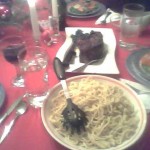 (Rachel’s pie, the Seitan Sauerbraten I made up), or that you got it wrong (the first attempt at the spun sugar nests). The balance, the flavors, how well, but not over-cooked things are–these are all there regardless of any recipe, regardless of even knowing what the experiment is supposed to taste like.
(Rachel’s pie, the Seitan Sauerbraten I made up), or that you got it wrong (the first attempt at the spun sugar nests). The balance, the flavors, how well, but not over-cooked things are–these are all there regardless of any recipe, regardless of even knowing what the experiment is supposed to taste like.
Some people need rules the way that other people need recipes.
They are not happy–well, generally, they just aren’t happy–but they just aren’t happy unless they have rigid rules and formulas to order their lives by. Anybody who doesn’t accept their rules is a danger, a challenge, a sinner, or–perish the thought–a relativist.
Rules are fine in certain circumstances.
Small children, like beginning cooks, need clear instructions and clear guidelines. There are also trickier situations, more complex situations where it is good to have worked out standards because the results could be so disastrous, and the long-term results are too difficult to see before it’s too late. In situations involving large groups of people, it is also good to have a clear understanding.
But virtue isn’t always dependent upon categorical imperatives or divine fiat. Sometimes we have to make decisions about how to react in an appropriate way, or how to be a good person, in the circumstances we find ourselves in. This isn’t relativism: a good cook doesn’t need a recipe to know that a dish is awful, and a good person does not need laws to understand that hurting another creature is wrong. A good cook knows that braising and slow roasting will give food more flavor, and a good person knows that patience and kindness make the world better.
Improvised Oatmeal
It recently occurred to me how odd my recipe collection here in my posts is. From reading here, one would get the impression that I cook mostly muffins; that is not the case. The recipes that I post are for things that I actually bother to follow a recipe for; most of the things I cook–the stews, pastas, potatoes & rice dishes that make up my day-to-day life aren’t necessarily planned, and certainly aren’t measured–and this is what most cooking, as well as most of my life, is like: I look at what’s available, and I make the best of it.
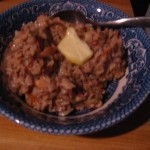 Among the best is this breakfast oatmeal, which my daughter and I started making after having some incredible oatmeal at the Tiny Cup Café in Brooklyn. The inspiration was theirs, but the genius behind it is probably my daughter’s.
Among the best is this breakfast oatmeal, which my daughter and I started making after having some incredible oatmeal at the Tiny Cup Café in Brooklyn. The inspiration was theirs, but the genius behind it is probably my daughter’s.
Ingredients:
- Oatmeal
- Milk or something like it (I use some unsweetened almond milk and a little sweetened)
- Salt
- Nuts
- Dried Fruit
- Fresh Fruit
- Pumpkin Seeds
- Sunflower Seeds
- Coconut
- Chocolate Chips
- Peanut Butter
- Whatever else you can think of
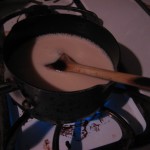
Step 1, Heat the liquid: It doesn’t matter how much, but I would advise about a cup per serving, I like to get it boiling first, then add a dash of cinnamon and salt, but you can do what you have to.
Step 2, Add the dry ingredients and stir, let simmer: Half 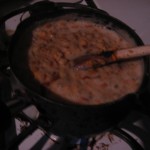 the amount of oatmeal that you added of liquid. If you are adding dried fruit (or fresh), I like to add it next so it softens, but you might like it firmer. At this point, I am digging through my nut drawers and seeing what there is to add. I love dried cherries, almonds, sunflower and pumpkin seeds, but I make do with what is in the drawer.
the amount of oatmeal that you added of liquid. If you are adding dried fruit (or fresh), I like to add it next so it softens, but you might like it firmer. At this point, I am digging through my nut drawers and seeing what there is to add. I love dried cherries, almonds, sunflower and pumpkin seeds, but I make do with what is in the drawer.
Step 3, Simmer: Until it gets firm and lumpy, maybe 20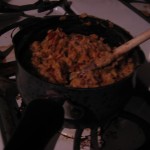 minutes; usually, I am ironing a shirt at this pint, so I don’t really know how long it takes.
minutes; usually, I am ironing a shirt at this pint, so I don’t really know how long it takes.
Step 4, Serve: I like a pat of butter on it, and maybe some brown sugar, but some people like a little more milk or cream.


